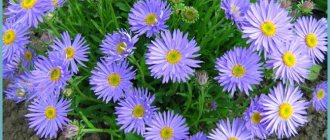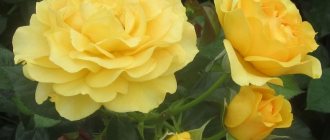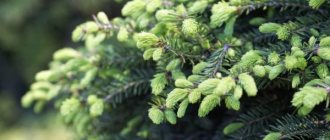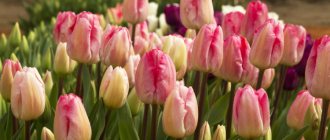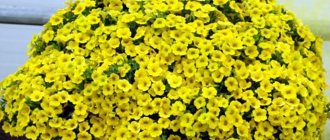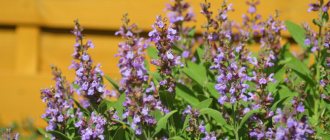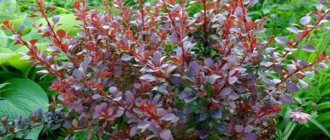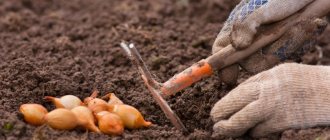Rogersia is an exotic perennial that attracts attention with its large, massive leaves.
The plant does not require much care and goes well with many other flowers, which is why gardeners like it.
Rogersia, planting and caring for it in open ground is very simple and even a beginner can do it, will become a unique plant, a real highlight of your garden!
Varieties and types with photos and names
This unique perennial came to us originally from China. It grows in mountainous areas and on moist soils, river banks, and lakes.
It has gained popularity in our country for its unpretentiousness and the ability to grow in shaded areas. There are many known species and varieties of Rogers.
Rodgersia aesculifolia is known for its large leaves that turn bronze with the arrival of autumn.
Rogersia pinnata has leaves with sharp edges. The most popular varieties: Chocolate Wings, Bronze Peacock, Elegance.
Rogersia podophylla or stopleaf (rodgersia podophylla) The leaves of Rogersia podophylla consist of five parts, they are very large and spreading. Varieties with burgundy leaves will perfectly decorate any area.
Rodgersia henrici It resembles ivy, its leaves are smaller. Also distinguished by decorative inflorescences.
Types and popular varieties of Rogers
— Horse chestnut leaf. So named for the external resemblance of the foliage to chestnut. Many hybrids of this species, for example, “Rodgersia purdomii” and “Rodgersia henrici”, have leaves that are initially beetroot-reddish in color, then gradually turn green. It blooms white or pale pink.
— Rogersia Henrizi is suitable for sunny areas, and its bush can reach a meter in height. Beige young foliage acquires a rich green color over time, the inflorescences are cream.
— The elderberry leaf type of crop is very unusual. Its inflorescences have a very pronounced aroma, and the Rotlau variety has massive bronze leaves and ivory flowers.
— Pinnate Rogersia is relatively low, maximum 70 centimeters. The leaves are wide, the flowers are snow-white (variety "Alba"), scarlet in the variety "Rubra" or pink - "Sureba". A hit of the last few years is an unusual variety with unusual foliage of a rich chocolate shade in spring and fall - “Chocolate Wings”. Its flowers come in all shades of pink and red.
— Centifolia or podophyllous Rogersia is simply a giant compared to other species, as it can reach a length of 160 cm. Its inflorescences are covered with delicate fluff, the petals are cream or white. This species will delight you with the most original varieties, for example, large majestic specimens of “Big Mama” or exotic multi-tiered inflorescences of “Pagoda”. The excellent hybrid “Irish Bronze” shows good endurance to various climatic growing conditions.
Transplantation and vegetative propagation
When replanting, you need to take into account the composition of the soil and the location on the site. Rogersia loves damp soil, but without stagnant moisture.
The ideal place would be areas near the wall of the house or near the fence. Such places are usually empty, since not all flowers like shaded and damp areas.
There Rogersia will happily begin to grow and spread its powerful leaves.
When replanting, it is important to remember that bushes grow widely.
It is necessary to leave more space between them so that they do not interfere with each other and do not block the light.
It is also not recommended to plant low-growing flowers near Rogersia, as it can cover them with lush foliage.
The flower is propagated by dividing the bush or cuttings; it is also possible to grow from seeds.
Dividing the bush
This method of reproduction is quite simple. To do this, the rhizome should be divided into several parts.
It is important that there are growth buds on each part of the rhizome. Their minimum quantity is 2-3 pieces.
Individual parts need to be planted in a new place in pre-prepared holes.
The distance between plants should be at least 60-100 cm.
It is recommended to plant new parts of the bush to a depth of 6 cm.
As for the timing, it is best to divide the bush in early spring or autumn.
The main thing in the autumn period is to be in time before the onset of frost. The fact is that the plant still needs to take root, which will allow it to better survive the winter.
Propagation by cuttings
This method can be used in mid-summer. To do this, you need to select strong and healthy cuttings.
You can put them in a container of water or place them directly in seedling pots with nutritious soil.
When new shoots appear, this means that the cutting has taken root.
During all this time, you need to regularly water the containers with cuttings. Then they are transplanted to a new place. This time usually falls in September-October.
Before wintering, be sure to cover the new planted cuttings with dry leaves and press them with something heavy so that they are not blown away by the wind.
When spring comes, it becomes warm, the shelter is removed. Rooted seedlings will actively grow.
In landscape design
Rogersia is one of the favorite plants of gardeners and landscape designers. She will find her place in any garden.
It is ideal for decorating flower beds, flower beds, borders, and ridges. A garden pond would be a great place for it. It will also serve as an excellent decoration for the banks of a reservoir. Another ideal location for Rogers is a rocky garden. Large rockeries are what the flower needs.
Horse chestnut-leaved Rogersia
Combinations of different types of this plant look very beautiful. Rogers also combines with other plants that grow in the shade, such as fern or hosta. This flower is luxurious next to plants such as astilbe, tiarella, and ostrich.
Cirrus "Chocolate wings" (Rodgersia Chocolate wings) in the garden
The plant also looks impressive in a composition with coniferous shrubs and trees, for example, thuja and juniper.
When planning a flower bed, you must remember that Rogers has a large height, so it will obscure low-growing flowers.
Growing from seeds
The method is rarely used due to the fact that it is quite long and is suitable only for patient people.
The seeds do not have good germination; the sprouts also develop very slowly.
Start sowing no earlier than the end of February.
The seeds need to be processed in advance.
To do this, they are placed in a damp cloth and wrapped in a bag.
After this, they are placed in the refrigerator for 14 days.
Next, proceed to sowing:
- Prepare containers (pots, boxes, cups), pour the soil mixture into them.
- Seeds are scattered over the surface. There is no need to sprinkle them with earth on top, as they are too small.
- Water with a spray bottle.
- Cover the containers with glass or film and put them in a warm place.
- With the emergence of shoots, the film is removed and the containers are transferred to the light.
Important! You need to add drainage or make holes at the bottom of the containers. They are necessary in order to avoid stagnation of moisture in the soil, as this can destroy the plants.
When the seedlings have 2-3 true leaves, you can plant them in separate cups.
Take care of the seedlings until warm weather sets in. Only then can you begin to transplant to a new place.
The optimal temperature at night should be at least +15°C.
Be sure to harden the seedlings before planting in open ground.
To do this, take containers with seedlings outside, gradually increasing the time they spend in the fresh air.
It is best to place seedlings in a shaded place where there are no drafts.
Why doesn't Rogers bloom or grow?
The plant is very beautiful, all its irresistibility lies in the green, fleshy large leaves, and not inflorescences.
Many gardeners are concerned that it sometimes does not begin to bloom. This usually happens due to improper care.
Most likely, the bush is missing something. It also happens when, due to an excess of nitrogen in the soil, the plant grows a luxurious green mass to the detriment of the flowers.
You can determine what is wrong with a flower by observing the bush.
Irregular watering can lead to the fact that the plant does not have time to set buds and therefore does not bloom.
This point is also affected by the location on the site. If there is not enough sunlight, the bush may not form buds for a long time.
The use of Rogers in garden design
Rogersia will not only decorate flower beds, edgings, mixborders, but will also serve as an excellent frame for a garden pond. By the way, if you plant Rogers near water or in a marshy area, its autumn colors will be especially bright and rich. Don't take your eyes off! Rogersia will do an excellent job as a plant for a rocky garden. True, it makes no sense to grow it on small alpine hills (it is too big), but in a large rock garden it will rightfully become a real high-altitude dominant.
Rogersia itself is highly decorative, however, by planting it in the garden along with hosta, bergenia, bells, fern or podophyllum, you can get very unusual and interesting compositions. The plant will look no worse in single-species plantings, sitting comfortably, for example, under the shade of trees on the lawn.
Outdoor care
Flower care involves regular watering and loosening the soil. It is also important to fertilize and mulch the soil.
Another important point is the removal of faded inflorescences and damaged leaves.
They significantly reduce the decorativeness of Rogers.
After it fades, seeds form on it, which need to be cut off.
If you need to collect and save planting material for further cultivation from seeds, then you can leave 1-2 seeds.
This will be quite enough, and it is recommended to leave them on those plants that are located in a less noticeable place.
Also, do not forget that Rogers must be carefully prepared for wintering so that the plant does not die from the cold.
Watering mode
The bush loves moisture very much. It is especially necessary to increase watering in hot weather. When the sun is scorching outside, it is recommended to water the plant at least 2 times a week.
You can use warm or cold water for this. Depending on weather conditions, the regularity of watering is adjusted.
In rainy weather, you can add moisture in smaller quantities or stop watering for a while.
Before covering the plant for the winter, you need to water it abundantly.
This type of watering is carried out under each bush, using at least 3 buckets of water.
This measure is necessary for Rogersia to set flowering buds.
The same watering should be carried out with the onset of spring. This time usually falls at the beginning of April.
Mulching the soil
The external beauty of a bush depends on many factors, one of which is the nitrogen content in the soil.
If there is enough of it, the leaves become fleshy and have a beautiful rich green color. They grow large and incredibly beautiful.
To do this, you need to add humus. You can also use soil from leafy trees.
This will create loose, light soil.
Oxygen will penetrate well to the roots of the plant, which is important for its development and flowering.
You need to mulch the soil when sprouts appear above the ground and have reached a height of 5-10 cm.
Mulching is carried out so that moisture is retained in the soil longer, and also to prevent the proliferation of weeds. For this you can use:
- sawdust;
- dry leaves;
- peat;
- straw;
- small crushed stone;
- pine cones or needles.
How to fertilize
In principle, the flower grows in poor soil. However, in order to grow a sufficiently powerful, beautiful and healthy plant, you need to feed it.
Only nitrogen-potassium-phosphorus fertilizers are used. Feed 2 times per season.
The first application of fertilizers is carried out before flowering, the second - after.
If you choose to fertilize with organic fertilizers, you can use mullein and bird droppings.
Pay attention to the concentration of the prepared solutions. Do not water the bush with undiluted fertilizers, otherwise you can burn the root system.
To prepare mullein fertilizer you need to do the following:
- Take a bucket and fill it halfway with mullein.
- Add water until the bucket is full.
- Place the contents, cover with a lid.
- Leave to ferment for 14 days.
Before watering, dilute 2 liters of prepared fertilizer with a full bucket of water. You can also use bird droppings for fertilizer:
- Take a bucket and fill it one third full with dry and fresh bird droppings.
- Pour water in there.
- Leave the prepared fertilizer to ferment for 10 days.
- After it has fermented, dilute half a liter of litter in a bucket of water.
How to protect against winter cold and spring frosts
In autumn, before frost sets in, the stems should be cut off close to the soil.
If winter is very cold, it is better to take care and cover the root circle with dry leaves, humus or peat.
The bush is not particularly winter-hardy, so some varieties of flowers may suffer from frost.
It is also recommended to cover the plant with non-woven material in early spring when the nights are cold.
Rogers care
Rogersia is capable of growing and developing well even in an area that is in deep shade. Moreover, it will bloom there abundantly with fragrant inflorescences. However, without proper and timely care, the plant may die.
How to care for the soil
The root system of such a plant is superficial, so do not forget to systematically inspect the soil surface around it. Throughout the growing season, the soil surface is regularly and very carefully loosened, while not forgetting to remove weeds. To saturate the soil with oxygen, hill up the plant. And to prevent excessive evaporation of moisture, the soil surface is covered with a layer of mulch. If you see that the roots are exposed, be sure to sprinkle them with a layer of soil or humus, otherwise they may dry out.
Fertilizer
It was discussed above that organic matter and mineral fertilizers need to be added to the soil before planting. Also, do not forget to feed the flower with the same fertilizers throughout the entire period of active growth and flowering. To do this, you need to choose fertilizers that contain sulfur, copper, zinc, iron, magnesium and phosphorus.
Watering
Rogersia is a moisture-loving plant, so make sure that the soil in the area does not dry out. In this case, Rogersia will delight you with lush flowering and spectacular foliage. Water the bushes systematically and abundantly, but do not allow liquid to stagnate in the soil, otherwise rot may appear on the roots.
Trimming
Promptly remove both withered flower stalks and foliage that has begun to dry out. This will preserve the decorative appearance of the bush. Unnecessary foliage that has dried out or been injured is cut off with pruning shears or a knife, and flower stalks are removed only if you do not need the seeds.
Transfer
If the site is suitable for growing this perennial, then it can grow in the same place for about 10 years (usually 8). Transplantation ahead of time is carried out only when the bush suffers due to too intense lighting or if rot has appeared on the root system due to stagnation of liquid in the soil.
Wintering
This heat-loving plant can withstand frosts down to minus 25 degrees. If the bush is properly prepared for winter, it will be able to overwinter quite normally in the open ground. In late autumn, cut off all the foliage along with the stems almost to the root, and then fill the area with a thick layer of mulch: sawdust, humus, fallen dry leaves or peat. However, if the winter is expected to have little snow, then before covering the area with mulch, it must be covered with a piece of non-woven polypropylene fabric, and its density should be at least 40–60 g/m2. In spring, non-woven material will help protect the plant from return frosts. Do not cover the bush with film, as it creates a greenhouse effect to which the flower reacts extremely negatively.
ROGERSIA LIATRIS
Resistance to pests and diseases
Rogersia is known for its resistance to many diseases. Pests also very rarely attack it.
The most common disease is rust fungus.
If you examine a plant affected by this disease, you can see dark spots on the green leaves.
To prevent and treat the disease, leaves and stems are treated with fungicides. It is recommended to remove and burn the affected parts of the plant.
It is better to treat bushes in the morning or evening.
It is advisable that the temperature is no more than +25°C.
If Rogers grows in wet areas or where water often stagnates, it may develop root rot.
The plant may die if measures are not taken.
You can get rid of the disease by transplanting the flower to another place.
If this is not possible, gardeners recommend digging up the bush and placing drainage at the bottom of the hole and planting the flower back.
Thus, excess moisture will accumulate in the drainage and will not harm the roots. The most common pests of Rogers are snails and slugs.
They eat the fleshy leaves and stems of the plant.
To combat it, it is recommended to use dry mustard. She needs to sprinkle the bushes early in the morning.
Rogersia flower: description
The plant migrated to Russian lands at about the same time as a result of expeditions to China through the Khingan Mountains, but was not described, so later the name Rogersia took root without hindrance.
Rogersia is a perennial herbaceous plant belonging to the Saxifraga family, genus Rodgersia.
Despite its origin, Rogers is suitable for the domestic climate: the flower can withstand the winter and, with proper watering and choice of location, survives the summer well.
Plant characteristics:
- It grows as a compact bush , which is endowed with a strong root system located horizontally.
- Rogersia is a fairly large shrub , reaching half a meter during the flowering period (depending on the variety).
- Palmately dissected leaf blades up to 50 cm long , which may seem like a giant resemblance to chestnut leaves, are located on elastic, mostly pubescent petioles.
- The peculiarity of Rogers is that, upon blooming and after flowering, the leaves acquire a purple, bronze or coffee hue instead of bright green.
- The inflorescences look like panicles dotted with pink, cream, and white small flowers.
- The flowering period , starting mainly in July, lasts up to a month.
- Blooming Rogersia exudes a pleasant, unobtrusive aroma , in addition to outstanding “external characteristics”, therefore it is known as an excellent honey plant.
Unfortunately, Rogersia is not well known to domestic flower growers and may be associated with difficulties in care. However, this is a myth that is easy to dispel.

